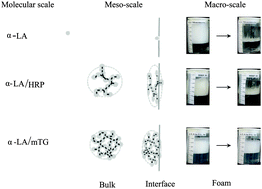Enzymatic cross-linking of α-lactalbumin to produce nanoparticles with increased foam stability
Abstract
Hard colloidal nanoparticles (e.g. partly hydrophobised silica), are known to make foams with very high foam-stability. Nanoparticles can also be produced from proteins by enzymatic cross-linking. Such protein based particles are more suitable for food applications, but it is not known if they provide Pickering foam stabilisation to the same extent as hard colloidal particles. α-Lactalbumin (α-LA) was cross-linked with either microbial transglutaminase (mTG) or horseradish peroxidase (HRP) to produce α-LA/mTG and α-LA/HRP nanoparticles. With both enzymes a range of nanoparticles were produced with hydrodynamic radii ranging from 20–100 nm. The adsorption of nanoparticles to the air–water interface was probed by increase in surface pressure (Π) with time. In the beginning of the Π versus time curves, there was a lag time of 10–200 s, for nanoparticles with Rh of 30–100 nm, respectively. A faster increase of Π with time was observed by increasing the ionic strength (I = 0–125 mM). The foam-ability of the nanoparticles was also found to increase with increasing ionic strength. At a fixed I, the foam-ability of the nanoparticles decreased with increasing size while their foam-stability increased. Foams produced by low-shear whipping were found to be 2 to 6 times more stable for nanoparticles than for monomeric α-LA (Rh ≈ 2 nm). At an ionic strength of 125 mM ionic strength and protein concentration ≥ 10 g L−1, the foam-stability of α-LA/mTG nanoparticles (Rh = 100 nm, ρapp = 21.6 kg m−3) was 2–4 times higher than α-LA/HRP nanoparticles (Rh = 90 nm, ρapp = 10.6 kg m−3). This indicated that foam-stablity of nanoparticles is determined not only by size but also by differences in mesoscale structure. So, indeed enzymatic cross-linking of proteins to make nanoparticles is moving a step towards particle like behavior e.g. slower adsorption and higher foam stability. However, the cross-link density should be further increased to obtain hard particle-like rigidity and foam-stability.


 Please wait while we load your content...
Please wait while we load your content...